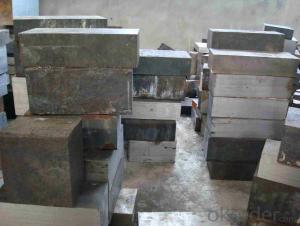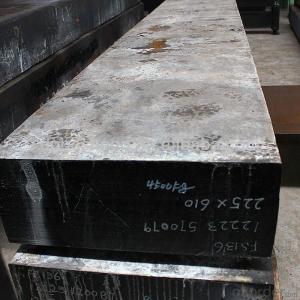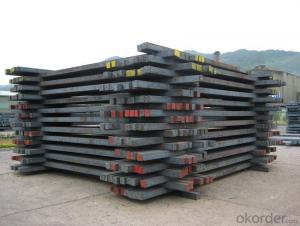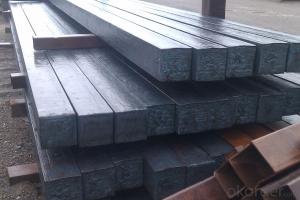Prime Q275 110mm Square Alloy Steel Billet
- Loading Port:
- Shanghai
- Payment Terms:
- TT OR LC
- Min Order Qty:
- 100 m.t.
- Supply Capability:
- 10000 m.t./month
OKorder Service Pledge
OKorder Financial Service
You Might Also Like
Structure of Prime Q275 110mm Square Alloy Steel Billet

Description of Prime Q275 110mm Square Alloy Steel Billet
1. Prepainted steel coil is coated with organic layer, which provides higher anti-corrosion property and a longer lifespan than that of galvanized or galvalume steel sheets.
2. The base metals for prepainted steel coil consist of cold rolled, HDGI Steel, electro-galvanized and hot-dip alu-zinc coated steel. The finish coats of prepainted steel coil can be classified into groups as follows: polyester, silicon modified polyesters, polyvinylidene fluoride, high-durability polyester, etc.
3. The production process has evolved from one-coating-and-one-baking to double-coating-and-double-baking, and even three-coating-and-three-baking.
4. The color of the prepainted steel coil has a very wide selection, like orange, cream-colored, dark sky blue, sea blue, bright red, brick red, ivory white, porcelain blue, etc.
5. The prepainted steel coils can also be classified into groups by their surface textures, namely regular prepainted sheets, embossed sheets and printed sheets.

Main Feature of Prime Q275 110mm Square Alloy Steel Billet
Uncoated CR steel sheet
With the features of in line with the international highest standards in demension and shape, excellent surface finish and properties, the products are mainly used in home appliance and automobile industries.
Galvanized steel sheet(include HDG and EG)
With the features of good corrosion resistance, the products are mainly used in automobile, home appliance, electronics, building and machinery manufacture industries, etc.
Precoated steel sheet
With the features of enviromental protection and good processablility, long lasting surface durability, rich in colors, the products are maily used in building, home appliance and furniture industries, etc.
Applications of Prime Q275 110mm Square Alloy Steel Billet
A. Corrugated design makes it excellent waterproof performance
B. Materials as prepainted steel sheets, galvanized steel sheets, galvalume (Al-Zn coated sheets) are available to make corrugated sheet.
C.Those material are durable, anti-corrosion in bad weather for 20-30 years based on it's Zinc(Galvanized) coating or AZ (Galvalume) coating.
D. Different shape of the sheet make it suitable for any style of buildings.
E.Easy to install, no need special tools to fix the sheet.
F.Light weight due to high strength to weight ratio of steel. Light weight means easier handling lower shipping costs, easier installation
G. Different color is availbe base on the RAL Standard make your building more beautiful.
H. We will provide the best solutions if you don't have a exact idea of the specification you want for the steel sheet based on your weather conditions, engineering structure, construction budget and so on.

Specifications of Prime Q275 110mm Square Alloy Steel Billet
Product | Billet |
Material Grade | SGCC / SGCH / DX51D+AZ, etc |
Thickness | 0.6-3.0mm |
Width | 500-1500mm |
Tolerance | Thickness: +/-0.02mm , Width:+/-2mm |
Zinc-coating | Z30-150g/m2 |
Technique | Raw material: Hot rolled steel coil --> Cold rolled_>hot dipped galvalume |
Surface | Dried, Chromated, Unoiled |
Spangle | Regular spangle , small spangle, zero spangle |
ID | 508MM 610MM |
Coil weight | 1-25MT |
Export package | Cardboard inner sleeves, Waterproof paper, galvanized steel covered and steel strip packed |
FAQ of Prime Q275 110mm Square Alloy Steel Billet
We have organized several common questions for our clients,may help you sincerely:
1. How Can I Visit There?
Our company is located in Tianjin City, China, near Beijing. You can fly to Tianjin Airport Directly. All our clients, from home or aboard, are warmly welcome to visit us!
2. How Can I Get Some Sample?
We are honored to offer you sample.
3. Why choose CNBM?
Our delivery time about 15-20days for standard sizes, if you have other requirements like hardness, quanity and width ,it is about 20-40days. But don't worry we also try our best for the delivery time ,because time longer and our cost is higher.
- Q:What are the different types of steel billet reheating furnaces?
- There are several types of steel billet reheating furnaces, including walking beam furnaces, pusher furnaces, rotary hearth furnaces, and roller hearth furnaces. Each type has its own advantages and uses, depending on the specific requirements of the steel production process.
- Q:How are steel billets used in the production of aerospace parts?
- Steel billets are used in the production of aerospace parts as they serve as the starting material for forging or machining processes. These billets are heated, shaped, and then further processed to create the desired components, such as engine parts, landing gear components, or structural elements, which are crucial for the performance and safety of aerospace machinery.
- Q:How are steel billets rolled or forged into other shapes?
- Steel billets can be rolled into other shapes through a process called hot rolling, where the billet is heated and passed through a series of rollers that apply pressure to shape it into the desired form. Alternatively, forging involves applying compressive forces to the heated billet, either manually or by using a machine, to reshape it into the desired shape.
- Q:What are the main factors affecting the metallurgical properties of steel billets?
- The metallurgical properties of steel billets are influenced by several key factors. These factors encompass the steel's composition, the applied heat treatment, the presence of impurities, and the rate at which it cools. The composition of the steel plays a pivotal role in determining its metallurgical properties. The steel's strength, hardness, and ductility are significantly impacted by the amount of carbon present, as well as the inclusion of other alloying elements like manganese, chromium, and nickel. Additionally, different compositions can affect the steel's ability to resist corrosion or exhibit magnetic properties. Heat treatment is another crucial factor that affects the metallurgical properties of steel billets. Through this process, the steel is heated to a specific temperature and then cooled at a controlled rate. By altering the steel's microstructure, heat treatment influences its hardness, toughness, and overall mechanical properties. Various methods of heat treatment, such as annealing, quenching, and tempering, can be employed to achieve desired metallurgical properties. The presence of impurities in the steel also has an impact on its metallurgical properties. Impurities like sulfur, phosphorus, and oxygen can have negative effects on the steel's mechanical properties, diminishing its strength and ductility. Hence, minimizing the level of impurities is crucial to ensure the desired metallurgical properties. Lastly, the cooling rate during the solidification process plays a pivotal role in determining the steel billets' microstructure and properties. Rapid cooling, as seen in quenching, leads to a fine-grained microstructure that enhances the steel's strength and hardness. Conversely, slow cooling, such as during annealing, results in a coarse-grained microstructure that improves the steel's ductility and toughness. In conclusion, the metallurgical properties of steel billets are influenced by factors such as composition, heat treatment, impurities, and cooling rate. These factors are interconnected and must be carefully controlled to achieve the desired properties for various applications.
- Q:What are the different forming processes used for steel billets?
- The different forming processes used for steel billets include hot rolling, cold rolling, extrusion, forging, and casting.
- Q:How are steel billets used in the energy and power generation industry?
- Steel billets are used in the energy and power generation industry for various purposes such as manufacturing turbine blades, generator parts, and structural components of power plants. These billets are essential in creating strong and durable equipment that can withstand the demanding conditions and high temperatures associated with energy production.
- Q:How are steel billets manufactured?
- Steel billets are manufactured through a process called continuous casting, where liquid steel is poured into a water-cooled mold to form a solidified billet shape. This billet is then further processed through reheating, rolling, and cooling to achieve the desired dimensions and properties.
- Q:How are steel billets used in the manufacturing of medical devices?
- The manufacturing of medical devices relies on steel billets in multiple ways. Surgical instruments, like scalpels, forceps, and scissors, use steel billets as a raw material. These instruments demand strength, durability, and corrosion resistance, qualities that steel billets possess. Steel billets also find use in the production of implants, such as joint replacements and dental implants. These implants must withstand the body's load and stress, making steel billets an ideal material due to their outstanding mechanical properties. Furthermore, medical equipment like hospital beds, wheelchairs, and surgical tables are manufactured using steel billets. These devices require a robust structure, and steel billets provide the necessary strength and stability. Moreover, steel billets are integral to the manufacturing of medical equipment components, such as brackets, frames, and supports. These components are crucial for the proper functioning and stability of medical devices, and steel billets are often selected for their high machinability and weldability. In summary, steel billets play a vital role as a raw material in the manufacturing of diverse medical devices. Their strength, durability, corrosion resistance, and other mechanical properties make them an excellent choice for producing surgical instruments, implants, medical equipment, and their components.
- Q:For example, screw plate (PU plate and manganese plate), carbon steel Primeton is what person rolling out?.
- Primeton Pu board generally refers to A3; carbon steel refers to the high quality carbon steel, such as No. 45 steel, 35 steel and so on; that in addition to the carbon and other elements, such as Cr, Mo etc., in which the carbon ratio below 30 for low alloy steel
- Q:What are the different types of surface defect detection equipment for steel billets?
- There are various types of surface defect detection equipment available for steel billets. These equipment are designed to identify and analyze defects on the surface of steel billets, ensuring that only high-quality products are used in various applications. Some of the different types of surface defect detection equipment for steel billets include: 1. Ultrasonic Testing (UT): UT equipment uses sound waves to detect surface defects in steel billets. It emits high-frequency sound waves that penetrate the material and reflect back when they encounter any surface irregularities. This method helps identify cracks, voids, and other defects on the surface. 2. Eddy Current Testing (ECT): ECT equipment uses electromagnetic induction to detect surface defects in steel billets. It works by passing an alternating current through a coil, generating a magnetic field that interacts with the conductive material of the billet. Any surface defect or irregularity will cause a change in the magnetic field, which can be measured and analyzed. 3. Magnetic Particle Inspection (MPI): MPI equipment uses magnetic fields and iron particles to detect surface defects in steel billets. The billet is magnetized, and iron particles are applied to its surface. These particles will gather around any surface defect, creating visible indications that can be easily identified and evaluated. 4. Visual Inspection: Visual inspection equipment involves the use of cameras, lasers, and other optical devices to detect surface defects in steel billets. These devices capture images or videos of the billet's surface and allow inspectors to identify any irregularities or defects visually. 5. Thermographic Testing: Thermographic equipment uses infrared cameras to detect surface defects in steel billets by measuring the temperature variations. Any defect will cause a difference in heat transfer, resulting in distinct thermal patterns that can be detected and analyzed. 6. X-ray Inspection: X-ray inspection equipment uses X-ray radiation to penetrate the steel billet and detect internal and surface defects. It provides detailed images that allow inspectors to identify cracks, voids, and other defects that are not visible to the naked eye. Overall, these different types of surface defect detection equipment for steel billets offer a range of methods to ensure the quality and integrity of the billets, enabling manufacturers to deliver high-quality steel products to various industries.
1. Manufacturer Overview |
|
|---|---|
| Location | |
| Year Established | |
| Annual Output Value | |
| Main Markets | |
| Company Certifications | |
2. Manufacturer Certificates |
|
|---|---|
| a) Certification Name | |
| Range | |
| Reference | |
| Validity Period | |
3. Manufacturer Capability |
|
|---|---|
| a)Trade Capacity | |
| Nearest Port | |
| Export Percentage | |
| No.of Employees in Trade Department | |
| Language Spoken: | |
| b)Factory Information | |
| Factory Size: | |
| No. of Production Lines | |
| Contract Manufacturing | |
| Product Price Range | |
Send your message to us
Prime Q275 110mm Square Alloy Steel Billet
- Loading Port:
- Shanghai
- Payment Terms:
- TT OR LC
- Min Order Qty:
- 100 m.t.
- Supply Capability:
- 10000 m.t./month
OKorder Service Pledge
OKorder Financial Service
Similar products
New products
Hot products
Related keywords
































